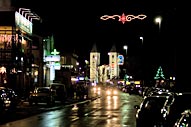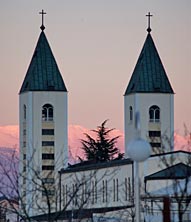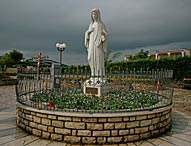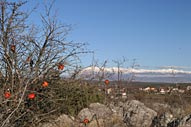date: 23.08.2006.
Mons. Joseph Vianney Fernando, Bishop of the Kandy diocese in Sri Lanka and president of the Bishop’s Conference of Sri Lanka came on a five-day pilgrimage to Medjugorje in July 2006. On Friday the 21st of July, he celebrated Holy Mass in English and gave a homily. He met the Franciscans at the Parish Office and discussed the Medjugorje events with them. Before leaving, he gave an interview and spoke about his diocese, his country and his impressions of Medjugorje. (Interview: Lidija Paris)
Thank you for being here and for accepting to give this interview. Would you be so kind as to present yourself, your diocese and your country?
I come from a country, which is situated at the southern end of India. It is a large island but a small country with a population of about 20 million. The majority - about 74% - are Buddhists, 7% are Christians, 7% are Muslims, and the remainder – approximately 14% - are Hindus. All the major religions are represented in our country. The two main languages are Singhalese and Tamil. As regards the Church, we have 11 dioceses and 13 bishops.
Christianity had already arrived in the 5th century. When Sri Lanka became a colony of the Portuguese in 1505, the Portuguese established the official Church. 150 years later, the Dutch took over. They are Presbyterians. They proscribed Catholicism, because they identified Catholicism with the Portuguese. They re-baptised all the Catholics and that was the crucial test for Catholics in Sri Lanka. Despite 150 years of persecution they steadfastly preserved their faith. When the Dutch became weak, the British Empire conquered Sri Lanka in 1806. They were Anglicans, but they were not hard on Catholics. Religious freedom was granted to the Catholics. Consequently the Church began to open schools all over the country. Because of those educational institutions, the Church gained a lot of influence. In 1948, after independence, a revival of Buddhism took place, which culminated in 1960 with the nationalisation of all of our schools. People protested and violence ensued, but we gave in. We didn’t fight. Our service to the nation in the whole area of education and formation was destroyed. Ten years later, the first insurrection took place in the south because of the new values such as Marxism etc. Then a violent revolution erupted in 1975…
We have had a long war in the country, followed by a ceasefire for about 3 years now, but again, there is every possibility that the war may break out again, a guerrilla war against the government by a minority of rebels. Since receiving independence from Britain, there is a persistent feeling that the Tamil minority is being discriminated against. It is a problem related to justice. The Tamil speaking people form 12 % of the population, and half of them live in the south interspersed among the Singhalese. In my diocese, I have 85,000 Catholics, 50% or more of whom are Tamil speaking. I myself speak both languages and all my priests are bilingual. Sri Lanka is a beautiful country. There is a very good climate in the south, but the northern part is dry. There are no industries. There are also areas of alleged discrimination. This is the current situation in Sri Lanka.
What is the Church doing in this situation?
The Church is in a very special position in relation to ethnic tensions. Only the Church - the Christians – attracted members from both groups. The Buddhists are all Singhalese and the Hindus are all Tamils. Moslems are also mostly Tamil speaking. There are 3 Tamil speaking bishops and 8 Singhalese speaking bishops. We co-exist in harmony without any problem. In 1993, the Bishop’s Conference of Sri Lanka wrote a pastoral letter about the prevailing situation at the time – a nation in crisis. We analysed the whole situation by outlining the perceptions both of the Singhalese people and of the Tamil people. To solve the problem however, we must search beneath those perceptions to discover the true reality of the situation. We - all the bishops together - have taken up the position that the solution must be within the framework of one sovereign country, but with the maximum devolution to the periphery and to the provinces. These conflicts are recent. The history of the country reaches back 2,500 years before Christ. Both the Singhalese and the Tamils came originally – thousands of years ago - from India. Both communities are well established with their traditions, their culture and their religions.
As I said, the bishops adopted the attitude that this problem has arisen because of the legitimate grievances of the Tamil speaking people in Sri Lanka. They must be redressed by devolution of power to the periphery.
What brings you to Medjugorje?
I have desired to visit Medjugorje ever since the apparitions began. In 1983, two years after the apparitions began, I became a bishop. I heard consistent reports from those visiting Medjugorje, who spoke in glowing terms of their truly tremendous spiritual experiences. “You have to go there, you have to see…” they would say to me. Many agencies asked me to come. If I had given in, instead of being bishop of Kandy, I would have been bishop off Kandy! A friend of mine, a priest in Palestrina near Rome, told me: “Next time you come to Europe, you have to visit Medjugorje. Our Lady wants you to come...” That touched me very much. I had only 6 days altogether. He told me that we needed at least 3 days for the visit. He arranged everything.
What have you been doing in Medjugorje?
We went up Apparition Hill and prayed the Rosary, and we spent a further 2 hours praying in different places. I concelebrated Mass… I came for Adoration… I believe that it is a place that has been touched by the divine. Otherwise, you cannot understand the kind of immediate spiritual atmosphere that the senses experience. I say this as a humble pilgrim, not as a bishop.
There is no contradiction between the two! Have you been hearing confessions?
One of the things that I was told was that I would be hearing confessions. How wonderful! This is Our Lady’s work. Secularism is spreading very quickly. Values are changing. Our Lady always comes to give the message of conversion… of sacrifice. I think it was badly needed.
Here in Medjugorje Our Lady calls herself the Queen of peace and of reconciliation.
Just observe what is happening in the world: Israel, Palestine, Lebanon, India, Kashmir, Sri Lanka, East Timor… God must be deeply concerned about this situation. At the Cross, Jesus gave us Mary as Our Mother…
Jesus says, “My peace I leave you, my peace I give unto you… not the way the world gives it…” What is the difference?
Jesus told us very clearly that peace cannot come through violence but through sharing and fraternal love. He promises us peace at its very deepest level. There is a beautiful English song: “Let there be peace on earth, and let it begin with me”.



